HTC One S Review - International and T-Mobile
by Brian Klug on July 17, 2012 9:30 AM ESTWe’ve already seen 1.5 GHz dual core Krait (MSM8960/MSM8260A/MSM8660A) performance before and talked about it in the HTC One X (AT&T) review, and the USA SGS3 review. For the most part, what we see with the HTC One S variants is largely the same as what we saw with a number of other dual core Krait based devices. Recall that MSM8960, MSM8660A, and MSM8260A differ only in baseband and thus what air interfaces are supported. The only big difference between the devices we've seen based on that SoC so far is RAM, and again the HTC One S includes 1 GB of LPDDR2.
If you’re looking for a detailed comparison to the International SGS3 with Exynos 4412, I've finally had a chance to play with one and we will be doing a more direct comparison with Tegra 3, Exynos 4412, and dual core Krait shortly. I've tossed in the numbers from the International SGS3 for comparison already.
For now, however, let's talk about the HTC One S.
JavaScript Performance
Measuring JavaScript performance is just one component of overall web browsing performance, but it’s the most mature in terms of something we can benchmark. Sunspider 0.9.1 is quite possibly the most well known of these JavaScript tests, and a regular staple of our testing suite:
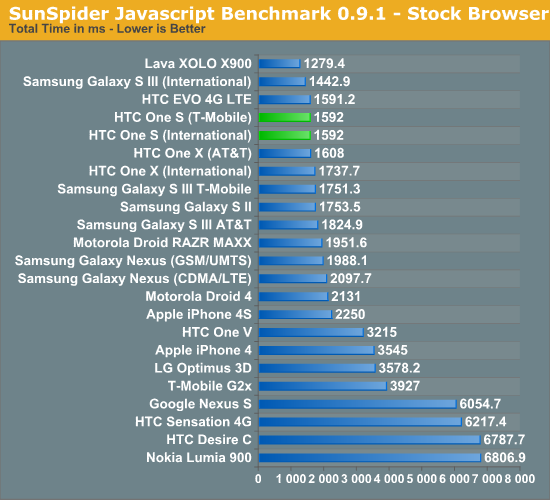
There's an obvious grouping of 1.5 GHz dual core Krait devices around 1500 ms. What spread there is between devices is primarily a function of whatever tweaks OEMs have made to the stock browser's V8 JavaScript engine.
Next up is Browsermark, which is another primarily JavaScript benchmark, with a few other measures. I'm told there are future versions planned which target HTML5 canvas performance.
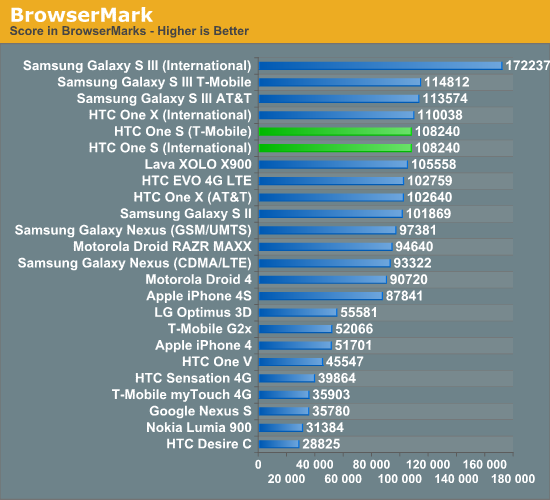
Again there's an obvious clump of dual core Krait devices. The International SGS3 pulls way ahead here for some reason.
Next up is Vellamo, which is a Qualcomm benchmark developed originally for OEMs to use and optimize their browser performance with, and later released for general use. It’s a regular member of our test suite and includes both JavaScript tests and scrolling tests that stress the display composition and hardware acceleration in an Android WebView.

Unsurprisingly the Qualcomm based devices do well in their own benchmark. All of the devices that score above 2000 feel very smooth browsing around in the stock browser and WebView. For the most part, choppy translation and zoom is a thing of the past on Android 4.x.
Low Level FP Performance
Linpack isn’t a great indication of overall smartphone performance, but it is a good test of the floating point capabilities of the CPUs in these SoCs. ARM has steadily been improving FP performance for the past few generations but we’re going to see a big jump to Krait/A15. As most client smartphone workloads are integer based and those that are FP heavy end up relying on the GPU, an advantage here doesn’t tell us much today (particularly because Linpack isn’t running native code but rather atop Dalvik) other than how speedy the FPUs are. There’s a new port of Linpack which runs using native code which we’ll be trying out in the big performance comparison piece.
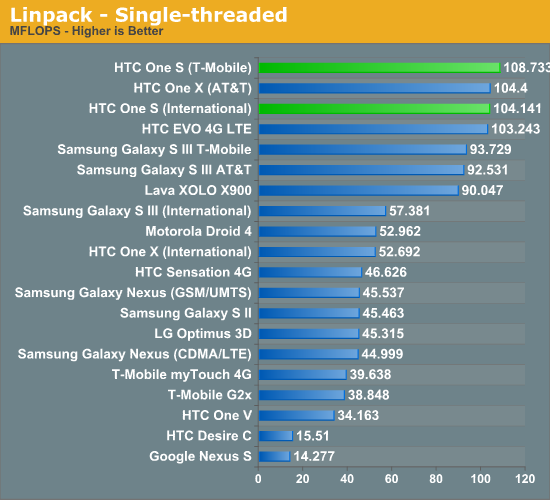
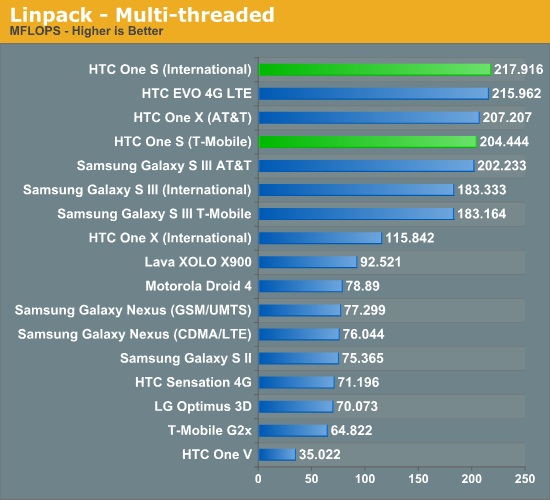
I'm becoming more and more dissatisfied with this GreeneComputing build of Linpack, and given the availability of some alternatives which are implemented natively as opposed to atop Dalvik, will probably move away from it very soon.
BaseMark OS
Rightware’s BaseMark OS is a general purpose benchmark designed to better simulate overall Android performance. It includes a heavily threaded benchmark, file IO tests, and compression/decompression tasks that all contribute to its overall score. This benchmark is pretty much the closest thing we have to a system benchmark for Android at this point, and is very close to achieving the same level of adoption that a few other big industry benchmarks have.
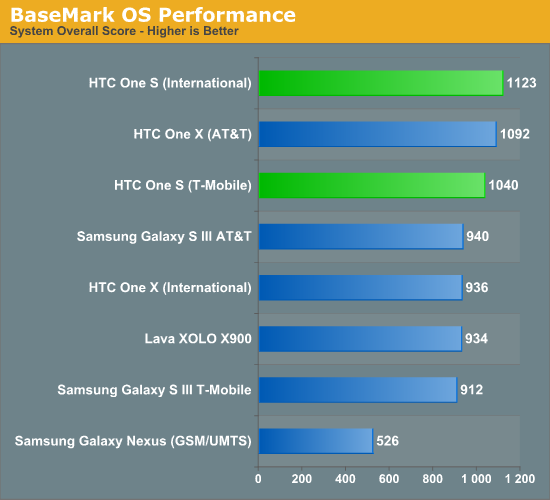
GPU Performance - GLBenchmark 2.1
As we wait for actual 3D gaming benchmarks to make their way into Android (and hopefully cross platform) games, we must rely on synthetic tests designed to simulate 3D game performance as best as possible. We start with GLBenchmark, one of the better Android GPU tests on the market today. There are two benchmarks, Egypt and Pro, and each is run in two modes: native screen resolution and offscreen (vsync disabled) at 720p. The latter is more useful for apples to apples comparisons as everything is rendering the same number of pixels, whereas performance in the onscreen tests is determined by the screen resolution of the device along with the performance of its GPU.
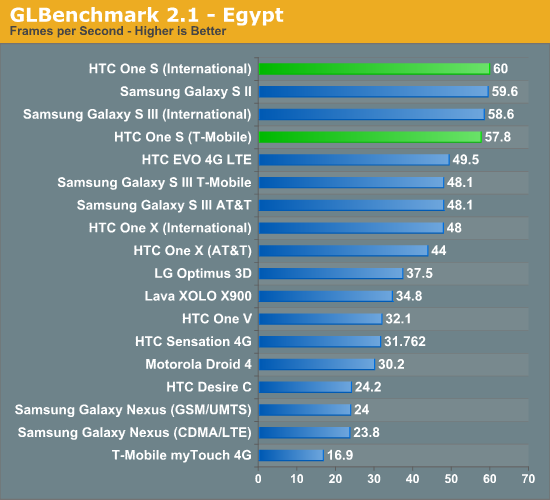

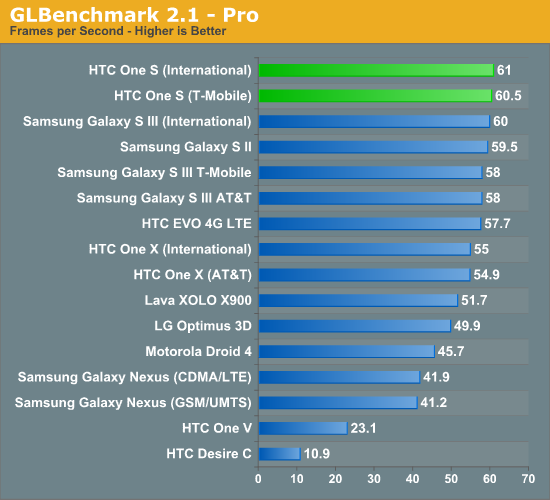
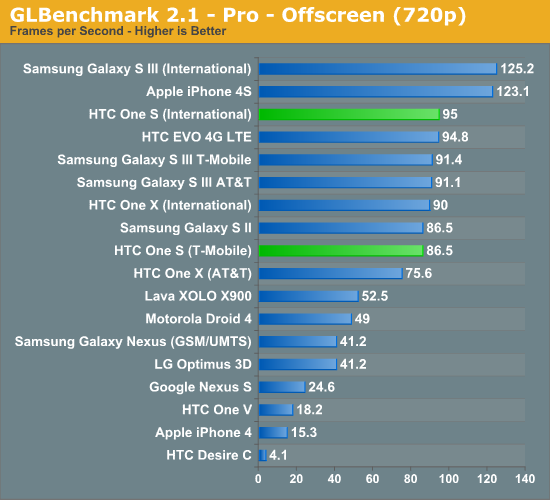
As a reminder, only the offscreen tests take place with vsync turned off, which is why you see devices with 720p displays posting different results on versus off screen where vsync is off. Part of the deal in getting Krait to market as quickly as possible required that Qualcomm pair the CPU with an older GPU, in this case the Adreno 225 instead of the newer Adreno 3xx offerings due out later this year in SoCs like MSM8960 Pro or the quad core Krait APQ8064. As a result, you can see the SGS2 with Exynos 4210 and the SGX543MP2 in the iPhone 4S pull ahead in some tests. Obviously the on-screen test isn’t a totally fair comparison because of the inherent difference in resolution - the One S is qHD.
Basemark ES 2.0 V1
Rightware’s Basemark ES 2.0 V1 is an aging GPU test that tends to favor Qualcomm’s Adreno GPUs above almost all others:
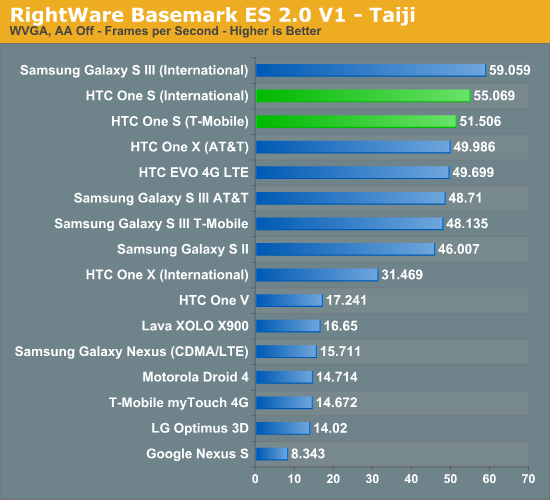
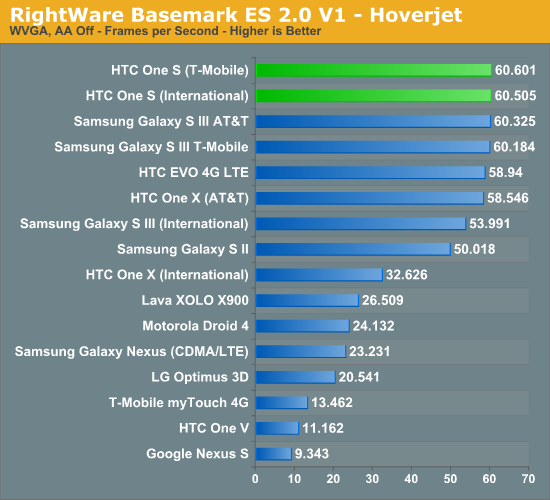
These two tests we run at WVGA on the device. Basemark ES 2.0 is definitely starting to show its age, as Hoverjet is at vsync essentially the whole time, and Taiji is nearly there as well. Qualcomm appears to be using ES 2.0 as an optimization target, so I wouldn’t put too much faith in the ES 2.0 results.










97 Comments
View All Comments
dgingeri - Tuesday, July 17, 2012 - link
as a One S owner for the last few months, I'm happy to say it's the best phone I've ever had. I'm thoroughly impressed with it. The only issues I have with it is that it's kind of hard to hold on to at times. I have dropped mine twice because the back surface is a bit slippery.I hadn't seen the cases, though. those look nice. I think I'll get one to offset that slippery back problem.
mgl888 - Tuesday, July 17, 2012 - link
Is there manual aperture control available for the camera? I don't see it in the GUI screen shots.Brian Klug - Tuesday, July 17, 2012 - link
No sadly, although no smartphones I'm aware of have variable apertures. Nokia gets closest by implementing an ND (neutral density) filter that attenuates light, but the aperture is fixed.-Brian
Zoomer - Thursday, July 19, 2012 - link
To be honest, the FOV difference is so small on the tiny lens.OCedHrt - Tuesday, July 17, 2012 - link
I've had a T-Mobile One S for about a month now and...1. I hate the USB port on the left - this makes the phone unusable as an incar GPS device because the USB cable is on the driver side.
2. Having just enough USB length for my previous phone with a USB port on the bottom, there just isn't enough left over reach with the USB port on the left.
3. Having the USB port just opposite of the volume buttons mean it's unavoidable you mess with the volume when plugging in the USB port with the screen on - such as when you're on the phone and try to plug it in only to find you've muted yourself.
4. HTC's marketing on this phone is very misleading - up until this article I did not know that T-Mobile's version did not have micro-arcing and I already have scuffs on metal back of the device.
5. The USB port also chips when trying to plug in the USB cable, as reported by many other owners. There is supposedly a revised version with a tapered USB port to fix this, but it seems not all carriers get it.
6. The power button on top is also not very accessible. As much as I prefer a HTC device over Samsung's, I still prefer power on one side with volume on the opposite. The usb power port on the bottom has not gotten in the way of me using the phone.
7. Finally, HTC seems to have silently swapped many One S's with higher clocked S3 instead of S4 due to shortages - this has created a bit of PR backlash in the affected markets.
Belard - Tuesday, July 17, 2012 - link
USB placement is never a perfect science... you are not holding it right :)Hence the only thing throwing me off of HTC phones is the power button on TOP and the vol rockers on the right side. Makes for 1 finger control I think. But for me and these HUGE phones, I didn't like. Samsung sticks its vol buttons on the left side, so they put their USB ports on the bottom, but they DID put them on the TOP for a while.
With this arrangement, thumb controls vol and index is more comfortable for the power.
For me, I think the top mounted USB makes a bit most sense, but doesn't look as good and in more danger of rain damage. With it on top, the phone can be oriented right when charging or is plugged into USB speakers. Mostly takes care of the GPS issue in the car... so top or bottom makes the most sense for a phone.
Again... thou, it still depends on the person.
PS: Hate rubber covers over the ports on phones, so its a fight to unplug those 1-3 times a day. Samsung used to use a plastic sliding door on the Galaxy S1.
OCedHrt - Wednesday, July 18, 2012 - link
It depends on how you use your phone. If you use your phone while it is plugged in, USB on top is also a bad idea. The only place where USB get's less in the way is on the side, or on the bottom. The problem with the left side is that is the driver side for most of us. This can be remedied by getting a car dock for the phone.Having buttons on the opposite side of the USB connector is also a bad idea, because you will push them while plugging in the cable.
The power button on top is okay, but it is hard to reach with one hand. For the Nexus S with the power on the right, and volume on the left, I never had any issues using the phone with one hand.
Reikon - Wednesday, July 18, 2012 - link
If your USB cable isn't long enough, just get a new one? They're like $3.And I've never had an issue pressing the volume buttons while plugging in USB. I've always held the phone on its bottom right (like how I normally hold the phone) while plugging in USB.
I do agree with the power button on the top being undesirable, though because being on top means it sometimes accidentally gets pressed while in my pocket, which brings me to another problem I have: the audio jack being on top.
I see no advantage to basically all phones having it on top. Having it on the bottom makes it so the cable doesn't potentially cover the screen and makes phones easier to pocket. When pocketing a phone directly from using it, you're naturally going to put it upside down, and headphones would get in the way for phones with the audio jack on top.
millerduck - Tuesday, July 17, 2012 - link
Massive problems with WiFi calling dropouts as well as poor performance in 1-2 bar cell areas. The HTC One S seems great in well-covered areas but on the edges it fails miserably. Other Android (MyTouch series) phones cope and can handle WiFi calling to supplement.On a network not known for consistent blanket coverage, this was the wrong handset!
MD
OCedHrt - Tuesday, July 17, 2012 - link
I have the same wifi problems - I've been trying to get it exchanged.And call static at times - not sure if correlated with signal yet.